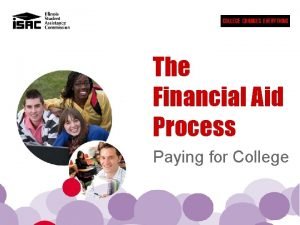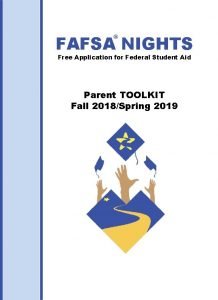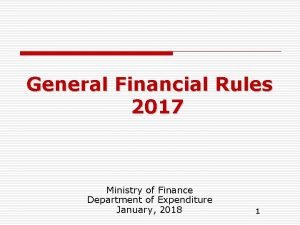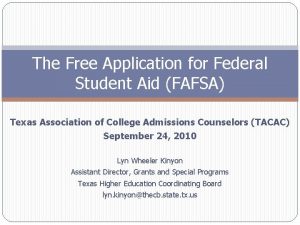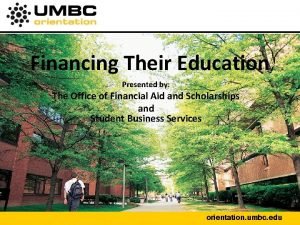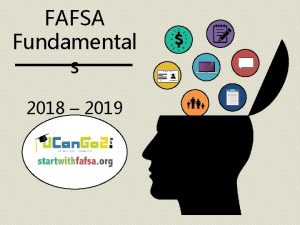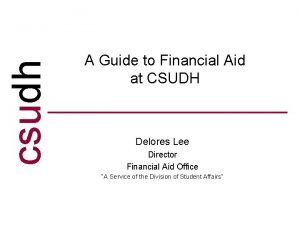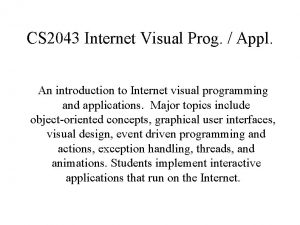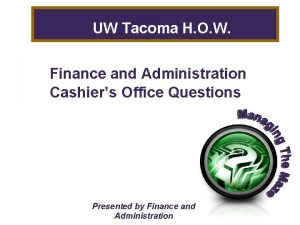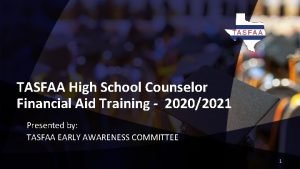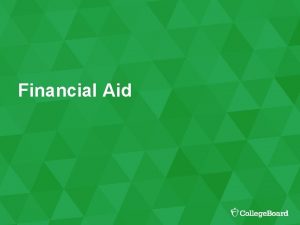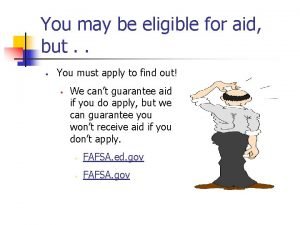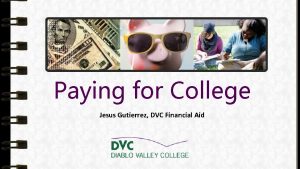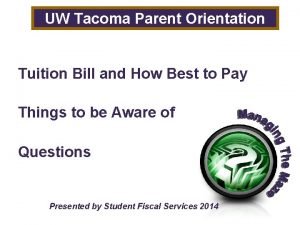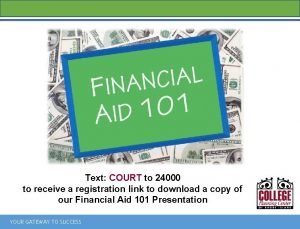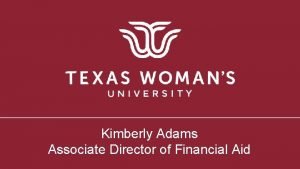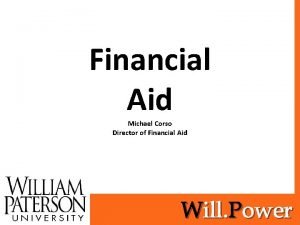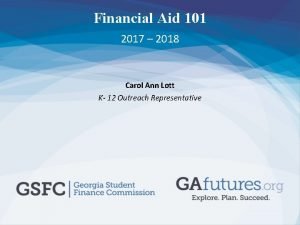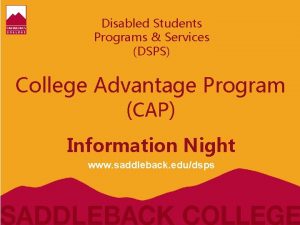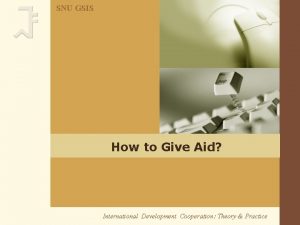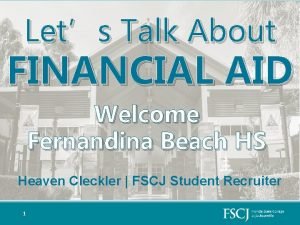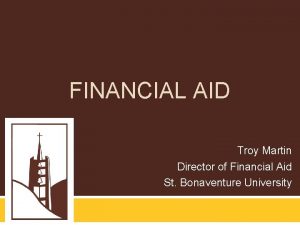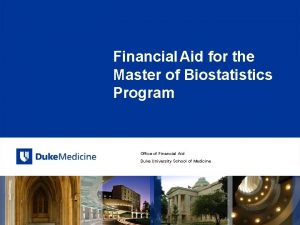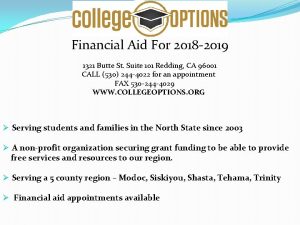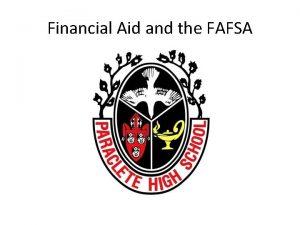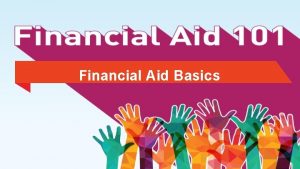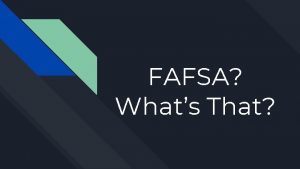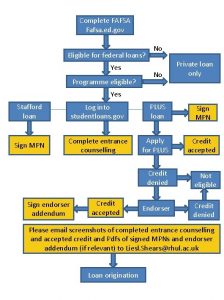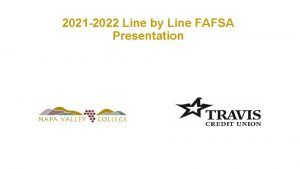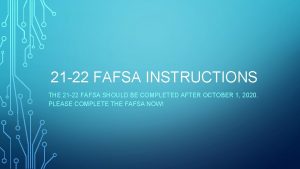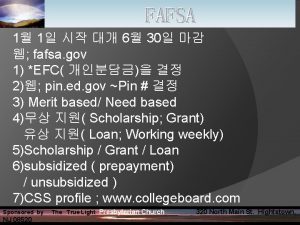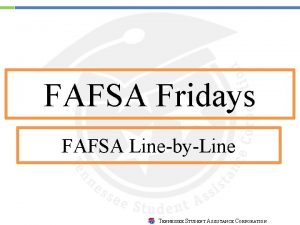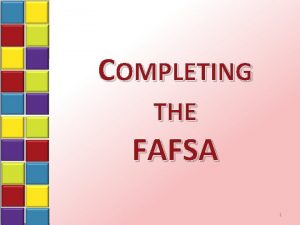Financial Aid 2017 2018 FAFSA Jennifer Knight Linfield











































- Slides: 43

Financial Aid & 2017 -2018 FAFSA Jennifer Knight Linfield College 1

Sources of paying for college • • • Family Private College State Federal How am I going to pay for college? 2

Financial Aid – What is it? Money from a source other than the family to assist with the cost of attending college s t n a r G Schol arship s 3

Who gets federal student aid? • U. S. citizens & eligible non-citizens • Must have a valid Social Security Number (SSN) • Selective Service Registration – males between 18 -25 • High school diploma or its equivalent • More eligibility criteria can be found at Student. Aid. gov/eligibility

Who gets state student aid in Oregon? • Oregon Opportunity Grant (OOG) – Applicants who file a Free Application for Federal Student Aid (FAFSA) at www. fafsa. gov and meet state eligibility criteria – Applicants who file the Oregon Student Aid Application (ORSAA) at www. oregonstudentaid. gov and meet state eligibility criteria • Oregon Promise at Oregon Community Colleges – Must complete Oregon Promise Application in OSAC Student Portal by deadlines, and – Complete FAFSA or ORSAA 5

How do I get started? • Completing the Free Application for Federal Student Aid (FAFSA®) is the first step toward getting federal aid for college, career school, or graduate school • Federal Student Aid, an Office of the U. S. Department of Education, provides more than $150 billion in grants, loans, and work-study funds each year, but you have to complete the FAFSA to see if you can get any of that money • The FAFSA is for everybody regardless of income • The FAFSA is student-centric 6

FAFSA Updates • 2017 -2018 FAFSA – Filing FAFSA date is earlier, begins October 1, 2016 – Will use prior-prior year (PPY) FAFSA Year File FAFSA on or after 2015 -2016 January 1, 2015 Tax Year Reported on FAFSA 2014 2016 -2017 January 1, 2016 2015 2017 -2018 October 1, 2016 2015 2018 -2019 October 1, 2017 2016

FAFSA – www. fafsa. ed. gov October 1 st 8 2017 -201 FAFSA 8

9

FSA ID Process – 3 Main Steps 1. 2. – – – Enter your log-in information Provide your email address, a unique username, and password, and verify that you are at least 13 years old Enter your personal information – 3. Provide your Social Security Number (SSN), name, and date of birth Include your mailing address, email address, telephone number, and language preference For security purposes, provide answers to five challenge questions Submit your FSA ID information – – Agree to the terms and conditions Verify your email address (This is optional, but helpful. By verifying your e-mail address, you can use your e-mail address as your username when logging into certain ED websites. This verification also allows you to retrieve your username or reset your password without answering challenge questions. )


Student - Login with FSA ID

Save Key

What’s on the FAFSA? • Student data, and spouse if married or parent data for dependent students – Demographic: Name, Date of Birth, Social Security Number, Address, and more – 2015 income – Additional Information – Untaxed Income – Federal benefits: SNAP, TANF, Medicaid, WIC, SSI, Free or Reduced Price Lunch – Assets • The colleges where you’re applying • Number of people in the household – Number in College: For dependent students, include themselves and their parent’s children who are in college at least half time at an eligible college in an eligible program

Assets (cont. ) • What’s an asset? – Total balances of cash, savings, and checking accounts as of the day you file the FAFSA – Net worth* of investments, includes real estate/other property, trust funds, money market funds, mutual funds, certificates of deposit, stocks, stock options, bonds, other securities, installment and land sale contracts, commodities, etc. – Net worth* of current businesses and/or investment farms. Don’t include a family farm or family business with 100 or fewer full-time employees • What’s not an asset? – Primary home you live in, retirement plans (401[k] plans), value of your life insurance, pension funds, annuities, non-education IRA’s, Keogh Plans *Net worth means the current value, as of the day you file the FAFSA, of investments, businesses, and/or investment farms, minus debts related to those same investments, businesses, and/or investment farms. Use $0 on FAFSA, if negative value.

Tabs across the top of the page indicate the steps to complete the FAFSA

Up to 10 Colleges


FAFSA: Determining Your Dependency Status Student. Aid. ed. gov You. Tube Video: https: //www. youtube. com/watch? v=d. Ebxa. Rjl. Lus


Unmarried and Married: Who are The Parents? • Never married, living separately: Include the legal custodial parent only • Never married, living together: Include both legal parents (note: do not include partners who are not the student’s parent) • Married: Include both parents or legal parent and stepparent

Frequently asked question: “My legal (biological or adoptive) parents are divorced, which parent should I list on the FAFSA? ” • Which parent have you lived with the most in the previous 12 months? • List this parent on the FAFSA, and their spouse if this parent is remarried Reminder: Do not list grandparents, foster parents, legal guardians, aunts, uncles, unless they have legally adopted you 22


Parent sections are always purple

Parent sections are always purple


Student Tax Information


2015 Additional Financial Information and Untaxed Income

Sign and Submit FAFSA

FAFSA Confirmation Page

Financial Aid Application Process Overview FAFSA • Student submits the Free Application for Federal Student Aid (FAFSA) – Electronically – Regular mail CPS SAR/ISIR • The Central Processing System (CPS) processes the FAFSA – Conducts required database matches – Calculates a student’s Expected Family Contribution (EFC) according to the federal need analysis • The student receives a Student Aid Report (SAR) as a result and the schools the student has listed receives an Institutional Student Information Record (ISIR) 32

After the FAFSA • • • Student Aid Report (SAR) Verification Special Circumstances College financial aid forms Award Letter Loans require additional steps at www. studentloans. gov before the funds can be disbursed to the student: – Master Promissory Note (MPN) – Entrance Counseling 33

Special Circumstances • Cannot report on FAFSA • Send letter in writing and supporting documentation to each financial aid office • Extenuating circumstances examples: – Change in employment status – Medical expenses not covered by insurance – Change in parent marital status – Unusual dependent care expenses – Student cannot obtain parent information 34

Financial Aid Eligibility Cost of Attendance (COA) – Expected Family Contribution (EFC) = Financial Aid Eligibility – “Need” • Cost of Attendance (COA) – – Tuition & Fees Room & Board Books & Supplies Personal, Transportation, Loan Fees • Expected Family Contribution (EFC) – FAFSA result from federal formula – Index, represents a family’s financial strength – Stays the same regardless of college – For dependent students, has two components student + parent = EFC

How much aid will I receive? • The financial aid office at your college will let you know the amount of financial aid you are eligible to receive • Your college will use your EFC to prepare a financial aid package to help you meet your financial need 36


Federal DL Annual Loan Limits for Undergraduate Students Grade Level Base Amount: Supplemental Total Subsidized/ Unsubsidized Annual Unsubsidized Maximum Additional Unsubsidized DEPENDENT INDEPENDENT UNDERGRADUATE And for dependent students whose parents cannot obtain Direct Parent PLUS Loan Total Annual Maximum INDEPENDENT UNDERGRADUATE And for dependent students whose parents cannot obtain Direct Parent PLUS Loan Freshman Sophomore $3, 500 $4, 500 $2, 000 $5, 500 $6, 500 $4, 000 $9, 500 $10, 500 Junior $5, 500 $2, 000 $7, 500 $5, 000 $12, 500 Senior $5, 500 $2, 000 $7, 500 $5, 000 $12, 500 38

Other loans • Student Loans – Private (Alternate) Education Loans • Apply with a bank/credit union – Institutional Loans • Check with the college to see if they are offered • Parent Loans – William D. Ford Federal Direct Parent PLUS Loan • For legal parents of dependent undergraduate students • Requires credit check • Requires a Master Promissory Note

When will I get my financial aid money?

Finding Scholarships • Start local, your home town – Your high school – Foundations – Community organizations and civic groups – Local business, and employers – Religious or ethnicity-based organizations • Your college/university • Your state – Oregon: www. oregonstudentaid. gov • Free internet search; search engines Beware of scams! 41

What can I do now? • Apply for Admission to your college choice(s) • Research financial aid process requirements at your college(s) – CSS/Financial Aid PROFILE® • Research scholarship deadlines and requirements • Obtain FSA ID (student and parent) • Net Price Calculator 42

Your Future Awaits! 43
 Linfield financial aid
Linfield financial aid Student aid.gov/fafsa
Student aid.gov/fafsa Fadera
Fadera Student aid.gov/fafsa
Student aid.gov/fafsa Student aid.gov/fafsa
Student aid.gov/fafsa Tsds peims 2017 2018
Tsds peims 2017 2018 Matura 2018/19
Matura 2018/19 Dada la siguiente secuencia rusia 2018 rusia 2018
Dada la siguiente secuencia rusia 2018 rusia 2018 First aid merit badge first aid kit
First aid merit badge first aid kit St andrew medical centre
St andrew medical centre Financial rules 2017
Financial rules 2017 Whats tasfa
Whats tasfa Iup verify my fafsa
Iup verify my fafsa Umbc fafsa code
Umbc fafsa code Fafsa metamarkup
Fafsa metamarkup Boston college fafsa deadline
Boston college fafsa deadline Efc fafsa chart
Efc fafsa chart Csudh financial aid office
Csudh financial aid office Fafsa metamarkup
Fafsa metamarkup Uwt parking pass
Uwt parking pass Tasfa 21-22
Tasfa 21-22 Fafsa fact or myth sheet
Fafsa fact or myth sheet Fafsa caster
Fafsa caster Dvc federal school code
Dvc federal school code My sis harbor college
My sis harbor college Fafsa+
Fafsa+ Faunet id
Faunet id Uw tacoma tuition
Uw tacoma tuition Fafsa ccri
Fafsa ccri Como funciona fafsa
Como funciona fafsa Twu financial aid staff
Twu financial aid staff William paterson fafsa deadline
William paterson fafsa deadline Gsfapps vs fafsa
Gsfapps vs fafsa Saddleback dsps
Saddleback dsps Baylor edu estimator
Baylor edu estimator Financial risk management conference 2018
Financial risk management conference 2018 Financial aid card
Financial aid card Southeastern louisiana university dual enrollment
Southeastern louisiana university dual enrollment Snu financial aid
Snu financial aid Financial aid midwestern state university
Financial aid midwestern state university Fscj financial aid office
Fscj financial aid office Troy financial aid office
Troy financial aid office Duke financial aid office
Duke financial aid office Butte financial aid
Butte financial aid



